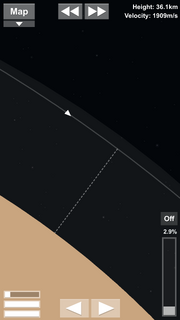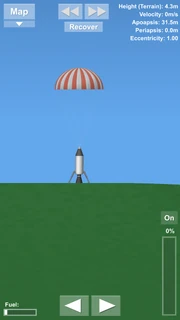(Grammar) Tag: Visual edit |
m (minor tweaking) |
||
| Line 12: | Line 12: | ||
[[File:Aerobrake.png|thumb|Aerobraking at Venus.]] |
[[File:Aerobrake.png|thumb|Aerobraking at Venus.]] |
||
| − | Landing speed can be significantly decreased on bodies with an atmosphere through [[Aerobrake|aerobraking]]. Instead of setting your transfer orbit to intersect the surface for a direct landing, set it slightly to the side such that the trajectory intersects the atmosphere. The atmosphere will decrease your velocity until you reach terminal velocity, from which you will fall at a constant rate, giving you lots of time to burn retrograde when the time is right, and open your parachute at low speeds, depending on which body you are attempting to land on. |
+ | Landing speed can be significantly decreased on bodies with an atmosphere through [[Aerobrake|aerobraking]]. Instead of setting your transfer orbit to intersect the surface for a direct landing, set it slightly to the side such that the trajectory intersects the atmosphere. The atmosphere will decrease your velocity until you reach terminal velocity, from which you will fall at a constant rate, giving you lots of time to burn retrograde when the time is right, and open your parachute at low speeds, depending on which body you are attempting to land on. |
===Parachuting to a stop=== |
===Parachuting to a stop=== |
||
[[File:Screenshot_2018-05-17-17-08-08.png|thumb|A landed suborbital rocket.]] |
[[File:Screenshot_2018-05-17-17-08-08.png|thumb|A landed suborbital rocket.]] |
||
| − | On these planets, you only need a parachute (more |
+ | On these planets, you only need a parachute (more if your craft is heavy). On [[Mars]], you might want to bring along extra objects to cushion your fall (e.g. [[Structural_Part|structural parts]]). Also, use more parachutes as their effect on Mars is lower! |
| − | ===Slowing using engines=== |
||
| ⚫ | |||
| + | |||
| ⚫ | |||
| + | |||
| + | |||
| + | |||
| + | |||
| + | |||
| + | |||
| + | |||
| + | |||
| + | |||
| + | |||
| + | ===Propulsive Landing=== |
||
| ⚫ | |||
| + | |||
| ⚫ | |||
Once you have reduced enough horizontal velocity. You will need to prepare for a [[Equations#Suicide_Burn|suicide burn]]. The burn is designed for the engines to run at 100% at the altitude calculated. It can be hard to burn exactly at the altitude, therefore one should start the burn a little bit earlier. |
Once you have reduced enough horizontal velocity. You will need to prepare for a [[Equations#Suicide_Burn|suicide burn]]. The burn is designed for the engines to run at 100% at the altitude calculated. It can be hard to burn exactly at the altitude, therefore one should start the burn a little bit earlier. |
||
| − | + | Landing by make landing burn(s) requires great familiarity with the speed control of the rocket. To perform this manoeuver, one should bring enough fuel as they usually take up more fuel than executing a suicide burn. |
|
There are no concise methods for doing this, but the main idea is to slow down enough to land safely. |
There are no concise methods for doing this, but the main idea is to slow down enough to land safely. |
||
| ⚫ | |||
| − | |||
| ⚫ | |||
| − | *[[Hard Landing]] |
+ | *[[Hard Landing]] |
*[[Fixed Point Landing]] |
*[[Fixed Point Landing]] |
||
[[Category:Gameplay]] |
[[Category:Gameplay]] |
||
Revision as of 02:04, 21 April 2019
For the video tutorial, click here.
Without Atmosphere
Objects with no atmosphere are the trickiest to land on. These include:
From Orbit
On the opposite side of your chosen landing area, burn retrograde until your periapsis is no lower than 5 km. if done correctly, your landing site should be directly below your periapsis. When you reach your periapsis, burn retrograde to kill all horizontal velocity. At this point, you should be in a parabolic arc and descending vertically. Decelerate such that you are moving at less than 200 m/s when you reach an altitude of 5.0km (Time Warp may not be available here, depending on the body which you are landing on). Always keep your velocity at under 50 m/s when your craft is 2.0km from the surface and try to get your velocity around 10 m/s when you're about to land.
With Atmosphere

Aerobraking at Venus.
Landing speed can be significantly decreased on bodies with an atmosphere through aerobraking. Instead of setting your transfer orbit to intersect the surface for a direct landing, set it slightly to the side such that the trajectory intersects the atmosphere. The atmosphere will decrease your velocity until you reach terminal velocity, from which you will fall at a constant rate, giving you lots of time to burn retrograde when the time is right, and open your parachute at low speeds, depending on which body you are attempting to land on.
Parachuting to a stop

A landed suborbital rocket.
On these planets, you only need a parachute (more if your craft is heavy). On Mars, you might want to bring along extra objects to cushion your fall (e.g. structural parts). Also, use more parachutes as their effect on Mars is lower!
Propulsive Landing
Landing propulsively is a difficult task. It requires some calculation to determine the amount of fuel required for a suicide burn and manoeuver the spacecraft accurately. In order to simplify the process, one should bring more-than-enough fuel.
First off, reduce most horizontal velocity. It can be especially difficult to land with excessive horizontal velocity. The reason for not eliminating all horizontal velocity is that one may want to fly to a designated landing area, and it will cost less fuel to eliminate the remaining velocity.
Once you have reduced enough horizontal velocity. You will need to prepare for a suicide burn. The burn is designed for the engines to run at 100% at the altitude calculated. It can be hard to burn exactly at the altitude, therefore one should start the burn a little bit earlier.
Landing by make landing burn(s) requires great familiarity with the speed control of the rocket. To perform this manoeuver, one should bring enough fuel as they usually take up more fuel than executing a suicide burn.
There are no concise methods for doing this, but the main idea is to slow down enough to land safely.